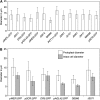An auxin gradient and maximum in the Arabidopsis root apex shown by high-resolution cell-specific analysis of IAA distribution and synthesis
- PMID: 19491238
- PMCID: PMC2714926
- DOI: 10.1105/tpc.109.066480
An auxin gradient and maximum in the Arabidopsis root apex shown by high-resolution cell-specific analysis of IAA distribution and synthesis
Abstract
Local concentration gradients of the plant growth regulator auxin (indole-3-acetic acid [IAA]) are thought to instruct the positioning of organ primordia and stem cell niches and to direct cell division, expansion, and differentiation. High-resolution measurements of endogenous IAA concentrations in support of the gradient hypothesis are required to substantiate this hypothesis. Here, we introduce fluorescence-activated cell sorting of green fluorescent protein-marked cell types combined with highly sensitive mass spectrometry methods as a novel means for analyses of IAA distribution and metabolism at cellular resolution. Our results reveal the presence of IAA concentration gradients within the Arabidopsis thaliana root tip with a distinct maximum in the organizing quiescent center of the root apex. We also demonstrate that the root apex provides an important source of IAA and that cells of all types display a high synthesis capacity, suggesting a substantial contribution of local biosynthesis to auxin homeostasis in the root tip. Our results indicate that local biosynthesis and polar transport combine to produce auxin gradients and maxima in the root tip.
Figures





Comment in
-
A high-resolution map of auxin distribution in the Arabidopsis root apex.Plant Cell. 2009 Jun;21(6):1621. doi: 10.1105/tpc.109.210610. Epub 2009 Jun 5. Plant Cell. 2009. PMID: 19502491 Free PMC article. No abstract available.
References
-
- Benfey, P.N., and Scheres, B. (2000). Root development. Curr. Biol. 10 R813–R815. - PubMed
-
- Benjamins, R., and Scheres, B. (2008). Auxin, the looping star in plant development. Annu. Rev. Plant Biol. 59 443–465. - PubMed
-
- Benková, E., Michniewicz, M., Sauer, M., Teichmann, T., Seifertová, D., Jürgens, G., and Friml, J. (2003). Local, efflux-dependent auxin gradients as a common module for plant organ formation. Cell 115 591–602. - PubMed
-
- Bhalerao, R.P., and Bennett, M.J. (2003). The case for morphogens in plants. Nat. Cell Biol. 5 939–943. - PubMed
-
- Bhalerao, R.P., Eklöf, J., Ljung, K., Marchant, A., Bennett, M., and Sandberg, G. (2002). Shoot-derived auxin is essential for early lateral root emergence in Arabidopsis seedlings. Plant J. 29 325–332. - PubMed
Publication types
MeSH terms
Substances
LinkOut - more resources
Full Text Sources
Other Literature Sources
Miscellaneous

